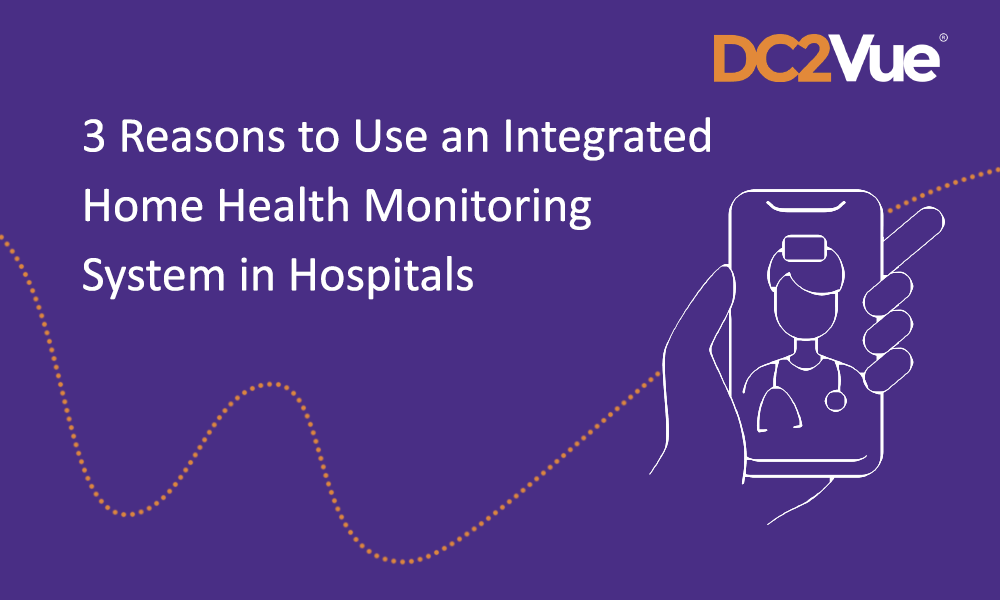16 hospitals in Victoria leverage DC2Vue home health monitoring technology to coordinate shared care and manage home health across a whole region.
Recently, but most especially now, the need for remote health services has been spotlighted. As the public gets advised to stay at home as much as possible, a home health monitoring system proves to be essential.
Read on to know more about the expanding importance of a remote patient monitoring solution.
What is Home Health Monitoring?
Home health monitoring is a game-changing virtual care technology that allows patients to receive clinical monitoring services from the comfort of their own homes; essentially, a hospital-in-the-home technology.
A home health monitoring system employs information technology and telecommunications to keep track of a patient’s health at home and guarantee appropriate action. Patients receive gadgets that measure and send vital signs such as blood pressure, glucose level, pulse, blood oxygen level, and weight to clinicians.
Furthermore, the home health monitoring system offers a variety of options for a patient’s traditional treatment. Again, this remote patient monitoring solution lowers healthcare costs and aids the hospital in improving the treatment process and providing a remote health monitoring system.
Continue reading to learn about three reasons why hospitals should employ an integrated home health monitoring system.
The Healthcare Landscape in Australia
Managing the rising cost of providing healthcare in Australia is a serious concern. Thus, health services aimed at the chronically ill and elderly can help to relieve the strain on the healthcare system and hospitals.
Introducing a hospital in the home technology resulted in significant savings in healthcare costs and patient lives.
According to research published by the Medical Journal of Australia, hospital in the home technology reduced the number and cost of GP visits, specialist consultations, and operations performed saved the healthcare system 24% over a year. In addition, the trial revealed a significant 53% reduction in hospital admissions. More importantly, you reduced the length of stay by 76%. When considering the projected cost of a hospital bed per day in Australia is over $2,051, this amounts to significant savings.
In addition, patients had a reduced death rate of more than 40%.[a]
Hospital in the Home Program
Hospital in the Home technology provides admitted care in the comfort of the patient’s home or other suitable location.
If you can deliver treatment safely at home, patients may receive this option. Patients do not get charged anything extra if they choose to participate.
Essentially, a hospital in the home technology is a remote patient monitoring solution, a viable alternative to an inpatient stay. Nurses, doctors, or allied health professionals may offer care, with additional home services established as needed.
Here are three reasons why hospitals should employ integrated home health monitoring systems.
1. Providers can use Home Health Monitoring to provide more efficient and effective treatment to patients in their homes.
Patient satisfaction gets enhanced by staying at home, having closer interactions with health professionals, having less anxiety, and having fewer emergency room visits and hospital stays.
Patients with chronic conditions benefit most from the remote health monitoring system. Because most chronic diseases are incurable, it is critical to keep an eye on the patient at home and respond immediately if their health signs deteriorate.
2. A home health monitoring system lowers healthcare expenses and saves the lives of patients.
A remote health monitoring solution allows healthcare providers to provide high-quality, more efficient treatment remotely. This remote option minimizes the need for frequent visits to patients while still offering high-quality support both face-to-face and remotely through user-friendly technologies.
3. A home health monitoring system frees up more beds in hospitals.
Full insight into the status and progress of patient cohorts helps to maximize the clinical workforce, reduce clinic congestion to enhance caseload, prevent avoidable readmissions, and improve hospital discharge.
Conclusion
A hospital in the home technology can evolve into an out-of-hospital environment where the rational deployment of technology, such as remote patient monitoring, behavioral activation, artificial intelligence, and prescriptive intelligence. This data, combined with the reasonable intersection of human adjudication, will notice patient deterioration for at-risk individuals well before they show traditional signs of deterioration.
This option will allow for a more timely and potentially less difficult intervention, preventing sickness progression and the need for acute, episodic, or unscheduled care.
Enter DC2Vue Home Health Monitoring technology.
Especially during the COVID-19 pandemic, DC2Vue Home Health Monitoring technology helps ease the burden on the healthcare system. Several hospitals in Victoria that provide hospital in the home (HITH) services have successfully implemented the remote patient monitoring technology with DC2Vue.
Care teams use the solution to call patients regularly to examine their health state by asking several questions regarding their blood oxygen level, temperature, respiration, and amount of activity and reviewing any underlying health concerns. The assessment tool assigns a risk score to each patient based on their answers to these questions, categorizing them as low, moderate, or high-risk and recommending next steps.
The DC2Vue Home Health Monitoring technology provides an enterprise-grade, scalable, collaborative, secure end-to-end, and cloud-based solution that features:
Complete Clinical Assessment
Clinical coordination via live dashboards
Patient Engagement
Integrations with PAS/EMR and other clinical systems
If you are a hospital-in-the-home service provider interested in learning more about home health monitoring technology solutions, contact DC2Vue today.



